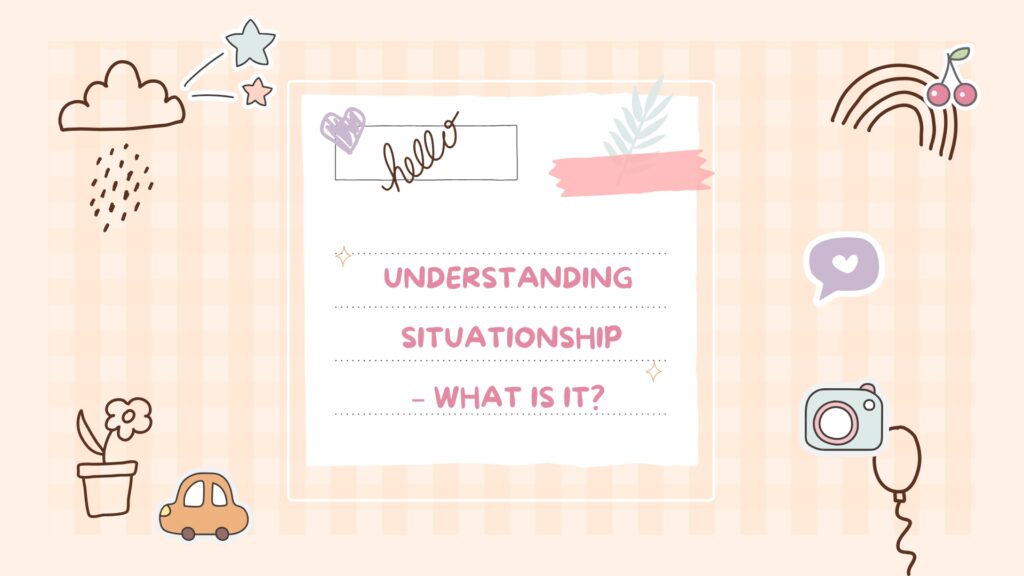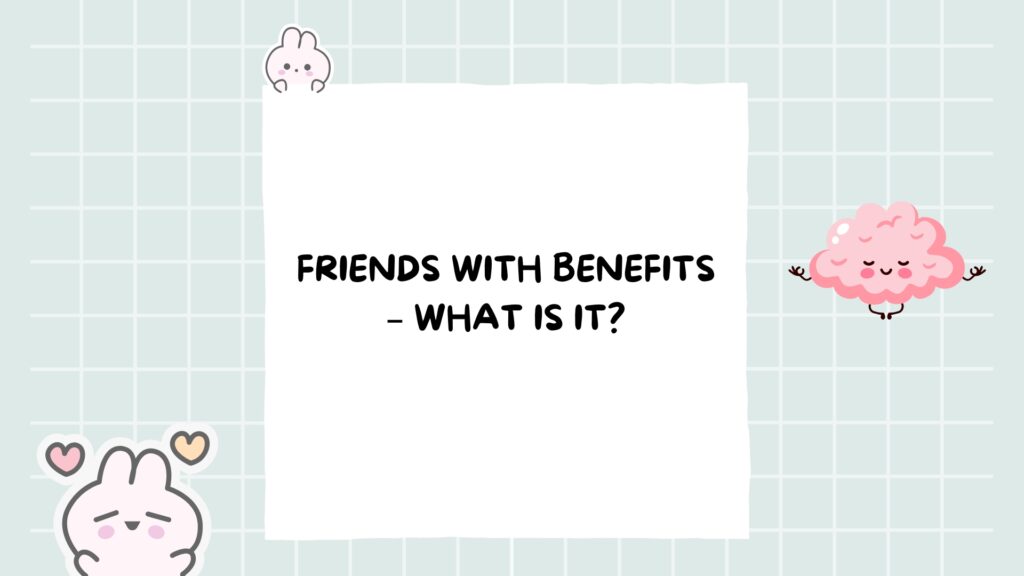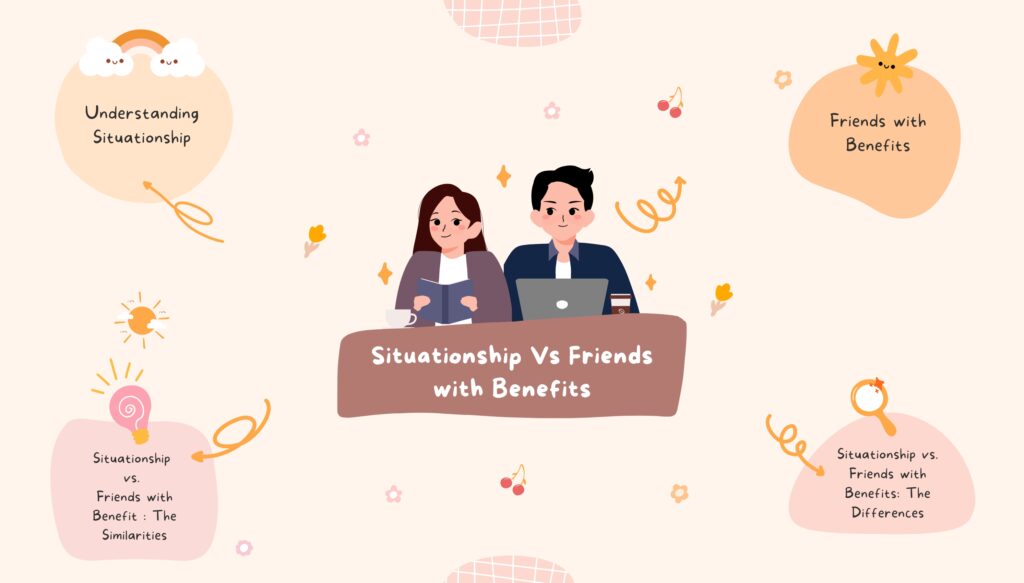Gone are the days when relationships were simple. Today, in a relationship itself, there are numerous formats, including committed relationships, situationships, and friends with benefits. A committed relationship is one where things are clear and two people are involved in a romantic relationship. That’s not the case with the other two formats of relationships. Both “situationship” and “friends with benefits” involve casual relationships. In these relationships, there is no commitment between partners. The two differ based on the level of emotional involvement between two individuals. So, if you want to understand what kind of relationship you are in, how these two arrangements differ, and their similarities, then read this post. Here, we will discuss everything about these two most popular formats of relationship in detail. Situationship vs Friends with Benefits So, let’s get started…
Table of Content
- Understanding Situationship – What is it?
- Friends with Benefits – What is it?
- Situationship vs. Friends with Benefits: The Similarities
Understanding Situationship – What is it?
Situationship refers to a romantic connection that is casual in nature. This type of relationship lacks commitment, which is pretty common when individuals are romantically connected. People in such relationships hang out together without a serious commitment. They spend time together and go for outings, but there is no commitment. This kind of relationship frequently involves mixed signals and unexpressed emotions. You must have observed that you enjoyed your friend’s company a lot. You love to spend time with him/her, but when it comes to sharing the same goals as people in romantic relationships do, it all seems vague.

In a situationship, two people enjoy each other’s company but do not know where they stand in each other’s life. These relations are often confusing, especially for people who start to invest emotionally without having any clarity about the future. People in situationships often find themselves trapped in a loop without knowing which way to choose.
Friends with Benefits – What is it?
A Friends with Benefits, as the name says, is a type of relationship or arrangement where two individuals seek benefits. When we say benefits, it usually includes indulging in sexual activities. Two individuals maintain a casual friendship where they indulge in sexual activities without any emotional commitment or expectations form each other. It allows both parties to enjoy intimacy while being free from any tag. Individuals in such an arrangement do not share common goals.

Unlike traditional romantic relationships, which are based on commitment, friends with benefits are often based on mutual understanding. Two individuals clearly communicate their requirements to each other and get into this arrangement without any force or expectation to avoid misunderstandings or emotional complications. However, this arrangement can only work well if individuals in friends with benefits arrangements are clear about their boundaries. Not having clarity or not establishing boundaries can lead to severe situations for either of the partners.
Let’s now take a look at the similarities of situationship vs. friends with benefits in the next section. Here we go…
Situationship vs. Friends with Benefits: The Similarities
There are numerous similarities between situationship and friends with benefits. Some of them are listed here. Take a look…
Casual in Nature
Both situationship and FWB are casual in nature. Individuals focus on the present moment, unlike committed relationships, where the entire focus is on building a deep connection.
No Emotional Connection
Both situationship and friends with benefits lack emotional connection. Individuals in these two arrangements are not emotionally connected; rather, it is fully physical.
Lack of commitment
None of the relationship types involves a serious commitment. Individuals in both types of relationships hang out and do several things together; they may even share OTT passwords or other confidential details with each other, but there won’t be any commitment.
No Expectation
None of the individuals in these arrangements have expectations or plans for a long-term future together. They only focus on present moments instead of the future.
Physical Intimacy
Physical intimacy is common in both these arrangements, especially in friends with benefits. Both these relationships involve sexual activity between the individuals.
Lack Label
Both situationship and FWB lack labels. Nobody acknowledges anything in these settings. People usually don’t like labeling these arrangements. Individuals don’t even take their connection with another person seriously.
Let’s now take a look at the differences between these two arrangements. Here we go….
Situationship vs. Friends with Benefits: The Differences
These two settings have numerous similarities; however, they differ in several aspects. Here are the differences between situationship and FWB. Take a look…
Emotional Connection
The level of emotional attachment differs between these two arrangements. In a situationship, there is emotional attachment without any commitment. Meanwhile, in a friends with benefits arrangement, there is no to minimal emotional connection. In FWB, two friends decide to have casual sex without any expectation and emotional attachment or commitment.
Ambiguity
Ambiguity is a common factor in both arrangements; however, it is more common in situationships. Situationships are more ambiguous, especially for one person who starts to see the future with the other person without any commitment. In a situationship, two individuals frequently spend a lot of time together, engage in numerous activities, and give the impression of being “dating” yet never formally clarify their relationship, leaving one person questioning the possibility of something more profound.
Clarity
There is clarity in friends with benefits relationships. Individuals start such relationships with clear intentions to seek sexual benefits from one another. But that’s not the case with situationship arrangements. Individuals in such settings get involved at deeper levels, with one potentially believing there’s a chance for a deeper relationship, while the other may see it purely as casual.
Communication
A friends with benefits relationship usually involves open communication about the boundaries and expectations of the arrangement, while a situationship might lack clear communication about what the relationship is.
Boundaries
Individuals in friends with benefits relationships establish clear boundaries to avoid confusion, which is not the case with situationship. In a situationship, one person often ends up having a deep attachment with the other person even after knowing there may be hardly any chance of building deeper connections.
Distinct Approach
Both are casual in nature; however, situationships often arise when two people start to spend a lot of time together, leading to a situation where they start loving each other’s company. This further leads to a situation where they indulge in physical activities as well. FWB begins with transparent and well-defined rules. Two individuals explicitly express their desires to one another, and if everything goes on smoothly, they begin to engage in intimate activities.
The Bottom Line
So, this is all about the situationship and friends with benefits relationship. Both the arrangements are casual in nature and lack commitment as well; however, there are too many differences between them. A “situationship” often involves more undefined romantic feelings and potential for emotional entanglement, whereas “friends with benefits” is typically purely physical, with a clear understanding that there are no deeper emotional expectations involved. Both lack a formal label and commitment, but situationships can be more ambiguous about where the relationship stands. FWB is all fun, with some ground rules and clear communication. Both are risky endeavours, especially for the ones who are emotionally weak. You never know when you will start to fall for another person, and the whole situation will become messier. So, be wise before you start your journey to fulfilment with either of these two modern-world dating approaches. Happy Relationship… 😊 😊
Pro Tip for Happier Relationships
Whatever you choose for yourself, make sure to have open communication. Doing so can help you avoid heartbreak, frustration, and resentment. Define the terms and set the pace before embarking on your quest for fulfilment.







